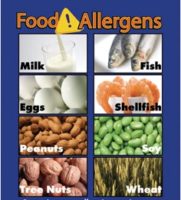A recent study has been published that focuses on the U.S. Food and Drug Administration (FDA)’s look at how existing recommendations for wiping and cleaning food-contact surfaces affect the presence of food allergens.
According to FDA, existing recommendations for wiping and cleaning food-contact surfaces are mainly focused on preventing microorganisms, such as bacteria and viruses, from contaminating foods. The effectiveness of these wiping and cleaning recommendations for preventing the transfer of food allergens in retail and foodservice establishments remains unclear.
FDA’s study, Allergen Removal and Transfer with Wiping and Cleaning Methods Used in Retail and Foodservice Establishments, investigated:
- Allergen removal from surfaces by wiping with paper wipes, terry cloth, and alcohol quaternary ammonium chloride (quat) sanitizing wipes;
- Cleaning of allergen-contaminated surfaces by using a wash–rinse–sanitize–air dry procedure; and
- Allergen transfer from contaminated wipes to multiple surfaces.
Food-contact surfaces (stainless steel, textured plastic, and maple wood) were contaminated with peanut-, milk- and egg-containing foods and subjected to various wiping and cleaning procedures. For transfer experiments, dry paper wipes or wet cloths contaminated with allergenic foods were wiped on four surfaces of the same composition. Allergen-specific lateral flow devices were used to detect the presence of allergen residues on wiped or cleaned surfaces. Although dry wipes and cloths were not effective for removing allergenic foods, terry cloth presoaked in water or sanitizer solution, use of multiple quat wipes, and the wash–rinse–sanitize–air dry procedure were effective in allergen removal from surfaces. Allergens present on dry wipes were transferred to wiped surfaces.
In contrast, minimal or no allergen transfer to surfaces was found when allergen-contaminated terry cloth was submerged in sanitizer solution prior to wiping surfaces. The full cleaning method (wash–rinse–sanitize–air dry) and soaking the terry cloth in sanitizer solution prior to wiping were effective at allergen removal and minimizing allergen transfer.
Overall, the study concluded that:
- Wet cloths and wipes were more effective in allergen removal from surfaces than dry wipes.
- Prescraping food from surfaces prior to full cleaning aided allergen removal.
- Cloth storage in sanitizer solution minimized allergen transfer between surfaces.
- Allergens were difficult to remove from a textured plastic surface.
The completed study and results have been published in the July 2020 issue of the Journal of Food Protection.




